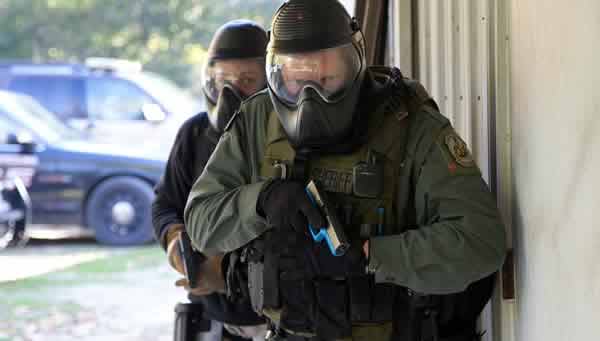
Why Instructors Lie about Disarming Techniques
You’ve got a gun to your head. Your heart is racing. Everything hinges upon a single moment of action and reaction. Compliance is no guarantee of survival. You have a window, a moment in time, an instance to act…your confidence is shaky, you’ve entered paralysis by analysis a million thoughts go through your head. You’ve lost control.
In this demonstration, Ryan Hoover a Krav Maga instructor candidly explains the reason why there are endless disarming techniques. In short, its to sell more courses. More classes. More DVDs. Its meant to make you feel like a commando ninja without actually improving your chances at survival. This is the great deception in the world of disarming techniques.
Let’s be real. You do not have an eternity to come up with all the what ifs and have an answer to each and every one of them. This is the inherent problem with collecting techniques rather than skill building and focusing on acquiring time tested principles. Enjoy the video and please leave us a comment.
Good Disarm Principles are:
- Redirect
- Control
- Counter Attack
- Disarm
Video Transcription
How new Techniques Get You Killed
“How’s it going everybody? GN Here today and I am joined by Ryan Hoover. We just had a seminar here in Markev, and one of the stand-out lessons here that really spoke to me was the idea of having just one or two techniques for a wide variety of situations. So first, can you take us through the basics of disarming? There’s three or four compartmentalized concepts there, which are…”
Ryan: “Yeah, we’re gonna start coming from the front, right-hand gun center mass to the chest kinda, keep it relatively basic. So, the basic principles are, I need to redirect line of fire– I need to get that half an inch that’s the only real dangerous part off of my body. So I’m gonna do that two ways: I’m gonna physically move the gun, and then I’m gonna move me. So redirect. Control, I need to get a second hand on the gun, in this case. In some other positions, it may be the gun arm.”
“What does your hand being in that position do to the firearm?”
Ryan: “Yeah, it does a couple of things. One: it allows me to secure it. Two: in most semi-automatic weapons, if the first round goes off, it’s gonna render it kinda out-of-operation, so he’s gonna have to tap-rack to make it work again. But more importantly for this context, it makes it very difficult for Josh to pull this gun back.”
“Because that’s what he’s gonna do.”
Ryan: “Yeah, for sure. About right now he’s going ‘Aw shit!’ and that’s the moment in time that I need to capitalize on. So I get that second hand on, he’s holding the part of the gun that’s meant to be held. I’m not. So by getting that second hand on, it allows me to have real control. Next part is counter-attack. I need to hit him.”
“Yup.”
Ryan: “So, as I’m getting that second hand on, here, I’m looking to counter. I’m fixing to kick straight up the middle. Finally, disarm, least important. I need to shut him down. I may kick him again, I may headbutt him or whatever. Line of fire should continue to move away from me, and come back to me. Here.”
“So that’s redirect, control, counter-attack, and take-away.”
Ryan: “Yep.”
“Let’s apply those four principles, let’s say if he’s got the gun to the back of your head…”
Ryan: “Yep. So it’s here. This is a really crappy place to find myself. So, redirection now, obviously no kinda hand defense, body defense, is gonna make much sense. If I try to redirect with my hands, this is very much in his line of sight. Remember, I’m not trying to beat the trigger pull, I’m trying to beat his reading my movement and then reacting to it. So if I make a big movement in here like this, he’s gonna see that, big time. So I may talk to the guy, I may try to figure out what he wants, because he wants something, he wants a wallet, he wants to move me from one place to another, he wants my truck, whatever. So from here, my redirection is I turn my head in. I get my head out of the line of fire as quickly as possible. I know, just like the other one, he’s gonna wanna pull that gun back, though, so I need to be there. I can’t stay in this place. So now, redirect, control becomes getting two-on-one here. You saw my counter-attack, right? Same knee at the same time, I wanna get outside here, and I look to make the takeaway. I chose to go inside of the elbows that time, I may go outside of the elbows, just based on totality of the circumstance. Maybe I’ve got some third parties next to me or whatever, maybe this is just the way that I looked, so the same thing I just go this way. I move my head, bring that knee in, punch over the top, break, take the gun.”
“Ok, so this is where– this is the part of the seminar– because you did the same concepts. Gun here, gun here, gun to the side, right? And then you said, ‘what if you can’t redirect to the left because you’ve got a loved one there, and you can’t redirect to the right, because there’s someone else there too’, and I thought you were gonna say ‘this is what you do, boom!’ like… but you’re not about having a billion techniques for a billion situations, because…?”
Ryan: “Yeah, it– look, let me borrow both of you guys for a second. If Josh is on one side, Amber’s on the other. So Paulo, you’re the badguy. You put the gun on me. So this is like, one of the most stressful situations I’m ever gonna find myself. If these are people that I love, and people that I care about, and whatever move I make is gonna put them in more danger, that’s gonna be really stressful. So do I now want another technique to have to remember under that kinda stress? No! So if this is what works for me alone, and maybe it’s what works if it’s on Amber and I can do this, then I don’t want another technique just because we’ve introduced a third person to it. So it’s perfectly normal, it’s perfectly natural, you put a gun on me, it’s ‘Ok, Ok bro, I’ll get you whatever you need, just, my wallet’s right here, let me get you my keys–‘ and now we’ve got this same thing. And all I did was change the environment. It’s, it’s– I don’t think anyone’s gonna think ‘oh man, I’ll get you whatever you need…’ now I’ve changed, I don’t have this huge long side anymore, I can redirect off my body, I don’t need a new technique. New techniques are great for selling seminars, selling DVDs, that kinda thing, having big fat curriculums. But I’m trying to make people safer, not sell a bunch of other stuff.”
“Awesome, so I just wanted to share that with you guys. For me, that was a really eye-opening concept in Ryan Hoover’s seminar today. I think he’s absolutely right, you know, I guess it’s fun, it’s kinda cool, it does sell more seminars and more DVDs, the more techniques that you have. But this is something different. Like, you’re changing the context of the situation to– it’s, I’m kinda speechless. So…”
Ryan: “I think we’re changing the way you think about it. Because everybody thinks ‘well we introduce a new problem, let’s come up with a new solution’, no! I don’t need a new solution! I can work within the framework that I already have if I start thinking that way.”
“Right, because if I wanted to shoot you, if my intention was just to shoot you, it would be from this far. It would be bangbangbangbangbang.”
Ryan: “Even if you walked up on me, we’re turned, you walk up, bang. Boom. Once the gun is up, if you want to shoot me, I’m shot. For this moment in time, you want something. And maybe I’ll give you that thing! I don’t know. If you wanna take one of my people with you, well that’s not gonna happen. We’re gonna fight. So context is always gonna dictate my response.”
“I like that. So we’ll end it with that. Context should dictate your response. I’m GN, Thank you guys for watching.”
Source: Ryan Hoover, Krav Maga



